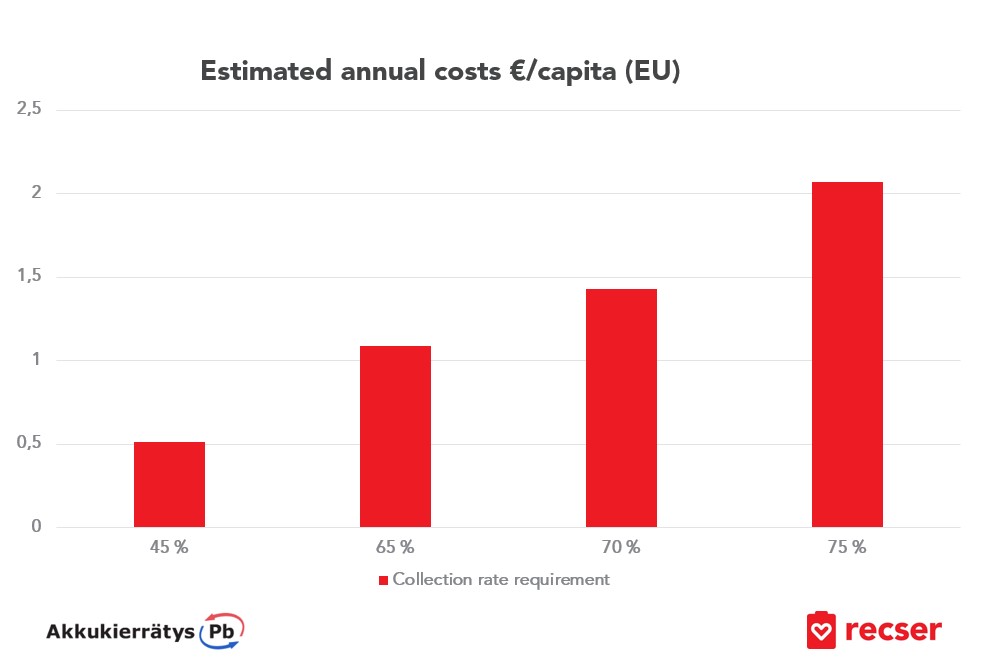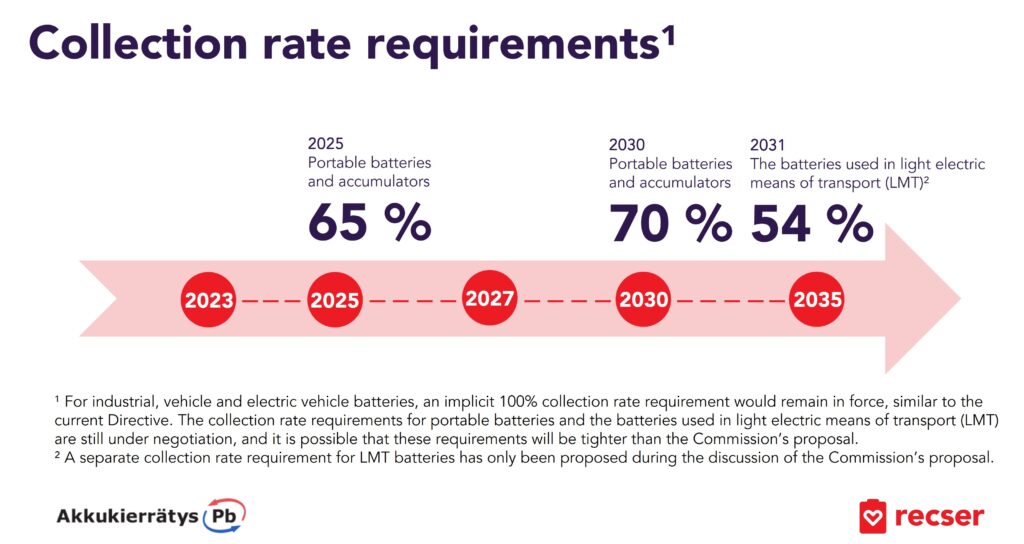By tightening the collection rate requirements, the aim is to protect the environment and improve the circular economy of batteries and accumulator, thereby also promoting the EU’s internal market.
The proposed EU Batteries Regulation proposes significantly tighter collection rate requirements for batteries and accumulators. The current collection rate requirement of 45% is proposed to be gradually increased to 70% by 2030. In addition, there is an intention to set a specific collection rate requirement for batteries used in light electric means of transport. The proposal implicitly states that other battery categories, i.e. batteries for vehicles and electric cars as well as industrial batteries, would continue to be subject to the 100% collection rate requirement. In practice, all batteries placed on the market should then be collected separately from other waste and recycled after disposal.

According to the impact assessment report of the regulation proposal, the higher collection rate requirements could achieve significant environmental benefits and emissions reductions,[1] especially for lithium batteries. In addition, the higher collection rate requirements could also create some new jobs, especially in the collection and transportation services.
Expenses of collecting and recycling are also highlighted
But will the tightening collection rate requirements have an impact on the cost of producer responsibility systems? According to the Commission’s impact assessment report, costs may double, or triple, compared to current levels.[2]However, it will depend on many factors, including the speed with which other measures can stimulate the market of recycled raw materials.

According to the Commission’s proposal, the collection rate would be calculated in the current way, on the basis of average annual sales over the previous three years (“batteries placed on the market”, “POM 3 years target”). In this way, the collection rate targets would be proportionate to the consumption of batteries in each Member State. However, this calculation method does not factor in the changes in the types, durability, service life and consumption patterns of batteries and accumulators, and may, therefore, lead to unrealistically high collection rate requirements. In particular, the share of lithium batteries in the market is constantly growing, and they often have a much longer service life than the non-rechargeable batteries. During the discussion of the proposal, it has been suggested that the method of calculating the collection rate should be changed to consider the batteries and accumulators that are actually available for collection during the year under review (“batteries available for collection”, AfC).[3]
A more realistic model for calculating collection rates
The AfC calculation model would factor in the increasing service life of batteries as realistically as possible. It would also factor in the batteries exported within electric and electronic devices for reuse or recycling in other countries. Their share is not yet taken into account in the statistics on waste subject to producer responsibility, and determining the actual number of them has presented a challenge.
As a result, the official collection rate does not show that the uncollected batteries and accumulators end up in mixed waste.[4] According to the impact assessment report of the EU Batteries Regulation, it is estimated that around a quarter of uncollected batteries and accumulators in the EU region may have ended up in mixed waste in 2015. The rest were either still in use, hoarded inside homes or ended up with electrical and electronic devices in other countries for recycling or reuse. This hoarding phenomenon means that devices are stored in homes as spare batteries or, for example, for nostalgia or security reasons, long after they have been discarded. Valuable electric and electronic devices and the batteries used in them often end up being hoarded.
This also delays the moment when it would be realistic to count the batteries as being available for collection. In order to provide more reliable data in the future on the number of batteries and accumulators ending up in mixed waste, the Commission proposes an obligation for the Member States to carry out “mixed waste surveys” at least every five years at the expense of the producer organisations. Based on the results of these surveys, the authorities could order producer organisations to take corrective action by improving the coverage of the collection network or by communicating more effectively, for example.
Mixed statistics on collection volumes in the EU countries
According to statistics collected by Eurostat, the EU achieved a collection rate of 51% for portable batteries and accumulators in 2019[5]. However, it is unclear how comprehensively and consistently sales and collection volumes are recorded across countries. For example, statistics show that Croatia has a collection rate of almost 90%, while Central European countries that have long developed collection systems only have a collection rate of 50–60%.
In Finland, the official collection rate was 49% in 2019. This figure is calculated on the number of batteries reported as placed on the market by the importers who are members of the producer communities and the separate collection volume reported by the producer communities. Therefore, the calculation of the collection rate does not factor in either the number of batteries placed on the market by “free riders” who do not take care of their producer responsibilities, or the number of batteries that end up in informal collection points or even in criminal hands. Changing the calculation methods of the collection rate to the proposed AfC model would also increase Finland’s collection rate, as about a third of portable batteries and accumulators sold in Finland are lithium batteries with a lifespan of three years or more. In addition, quite significant quantities of electric and electronic devices are exported from Finland for reuse, so they never end up as waste here.
Realistic collection rates contribute to fairness
How realistic and achievable the collection rate requirements are will become increasingly important in meeting producer responsibilities. Under the proposed EU Batteries Regulation, collection rates would become specific to each producer organisation and a failure to achieve them could lead to the withdrawal of the producer organisation’s approval. That is why it is increasingly important for the position of producers that they retain the primary right to collect the waste for which they are responsible, and that the collection rate calculations are based on the batteries and accumulators that can actually be collected.
Recser and Akkukierrätys Pb have raised these issues on several occasions during the discussion of the proposal for the EU Batteries Regulation, commenting on it to the representatives of the Ministry of the Environment, Commission and Parliament.

[1] SWD(2020) 335 final. COMMISSION STAFF WORKING DOCUMENT: IMPACT ASSESSMENT REPORT. Accompanying the document Proposal for a Regulation of the European Parliament and of the Council concerning batteries and waste batteries, repealing Directive 2006/66/EC and amending Regulation (EU) 2019/1020. (Commission impact assessment report).
[2] Commission impact assessment report p. 47.
[3] Huisman, J., Bobba, S., “Available for Collection” study on alternative collection targets for waste portable and light means of transport batteries, EUR 30746 EN, Publications Office of the European Union, Luxembourg, 2021.
[4] The Centre for Economic Development, Transport and the Environment (ELY Centre) of Pirkanmaa. Producer responsibility statistics (in Finnish): https://www.ymparisto.fi/fi-FI/Kartat_ja_tilastot/Jatetilastot/Tuottajavastuun_tilastot/Akku_ja_paristotilastot
[5] https://ec.europa.eu/eurostat/statistics-explained/index.php?title=Waste_statistics_-_recycling_of_batteries_and_accumulators
This article is a part of the joint communications of the battery and accumulator producer organisations Recser Oy and Akkukierrätys Pb Oy concerning the EU Batteries Regulation. You can also subscribe to our newsletter to receive the latest news on the subject.
